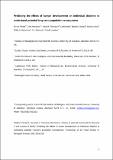Files in this item
Predicting the effects of human developments on individual dolphins to understand potential long-term population consequences
Item metadata
| dc.contributor.author | Pirotta, Enrico | |
| dc.contributor.author | Harwood, John | |
| dc.contributor.author | Thompson, Paul | |
| dc.contributor.author | New, Leslie | |
| dc.contributor.author | Cheney, Barbara | |
| dc.contributor.author | Arso Civil, Monica | |
| dc.contributor.author | Hammond, Philip Steven | |
| dc.contributor.author | Donovan, Carl Robert | |
| dc.contributor.author | Lusseau, David | |
| dc.date.accessioned | 2016-10-28T23:34:09Z | |
| dc.date.available | 2016-10-28T23:34:09Z | |
| dc.date.issued | 2015-11 | |
| dc.identifier | 226880840 | |
| dc.identifier | c733a32b-8610-4e6d-9bfd-b587bf99a64d | |
| dc.identifier | 84945940765 | |
| dc.identifier | 000364850200017 | |
| dc.identifier.citation | Pirotta , E , Harwood , J , Thompson , P , New , L , Cheney , B , Arso Civil , M , Hammond , P S , Donovan , C R & Lusseau , D 2015 , ' Predicting the effects of human developments on individual dolphins to understand potential long-term population consequences ' , Proceedings of the Royal Society B: Biological Sciences , vol. 282 , no. 1818 , 20152109 . https://doi.org/10.1098/rspb.2015.2109 | en |
| dc.identifier.issn | 0962-8452 | |
| dc.identifier.other | ORCID: /0000-0002-2381-8302/work/47531605 | |
| dc.identifier.other | ORCID: /0000-0001-8239-9526/work/27166740 | |
| dc.identifier.other | ORCID: /0000-0002-1465-5193/work/68647704 | |
| dc.identifier.uri | https://hdl.handle.net/10023/9731 | |
| dc.description | This work received funding from the Marine Alliance for Science and Technology for Scotland (MASTS pooling initiative). | en |
| dc.description.abstract | Human activities that impact wildlife do not necessarily remove individuals from populations. They may also change individual behaviour in ways that have sublethal effects. This has driven interest in developing analytical tools that predict the population consequences of short-term behavioural responses. In this study, we incorporate empirical information on the ecology of a population of bottlenose dolphins into an individual-based model that predicts how individuals' behavioural dynamics arise from their underlying motivational states, as well as their interaction with boat traffic and dredging activities. We simulate the potential effects of proposed coastal developments on this population and predict that the operational phase may affect animals' motivational states. For such results to be relevant for management, the effects on individuals' vital rates also need to be quantified. We investigate whether the relationship between an individual's exposure and the survival of its calves can be directly estimated using a Bayesian multi-stage model for calf survival. The results suggest that any effect on calf survival is probably small and that a significant relationship could only be detected in large, closely studied populations. Our work can be used to guide management decisions, accelerate the consenting process for coastal and offshore developments and design targeted monitoring | |
| dc.format.extent | 9 | |
| dc.format.extent | 1782196 | |
| dc.language.iso | eng | |
| dc.relation.ispartof | Proceedings of the Royal Society B: Biological Sciences | en |
| dc.subject | Behavioural response | en |
| dc.subject | Human development | en |
| dc.subject | Individual-based modelling | en |
| dc.subject | Individual heterogeneity | en |
| dc.subject | Management | en |
| dc.subject | Population consequences of disturbance | en |
| dc.subject | QH301 Biology | en |
| dc.subject.lcc | QH301 | en |
| dc.title | Predicting the effects of human developments on individual dolphins to understand potential long-term population consequences | en |
| dc.type | Journal article | en |
| dc.contributor.institution | University of St Andrews. School of Biology | en |
| dc.contributor.institution | University of St Andrews. Scottish Oceans Institute | en |
| dc.contributor.institution | University of St Andrews. St Andrews Sustainability Institute | en |
| dc.contributor.institution | University of St Andrews. Centre for Research into Ecological & Environmental Modelling | en |
| dc.contributor.institution | University of St Andrews. Sea Mammal Research Unit | en |
| dc.contributor.institution | University of St Andrews. Marine Alliance for Science & Technology Scotland | en |
| dc.contributor.institution | University of St Andrews. School of Mathematics and Statistics | en |
| dc.identifier.doi | 10.1098/rspb.2015.2109 | |
| dc.description.status | Peer reviewed | en |
| dc.date.embargoedUntil | 2016-10-28 |
This item appears in the following Collection(s)
Items in the St Andrews Research Repository are protected by copyright, with all rights reserved, unless otherwise indicated.

